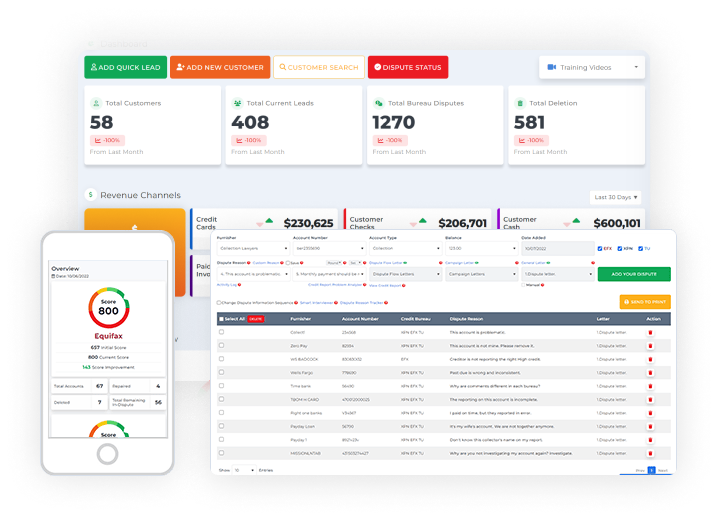Are you tired of seeing inaccurate late payments on your credit report, dragging down your score and hindering your financial progress? It’s time to take action and learn how to write a compelling late payment removal letter, including using strategies like the 609 letter to remove late payments and the goodwill letter to remove late payments to erase those mistakes and get back on track.
Inaccurate information on your credit report can have far-reaching consequences, affecting your ability to secure loans, credit cards, and even housing. By addressing these issues head-on and learning how to effectively communicate with creditors and credit bureaus, you can take control of your credit health and pave the way for a brighter financial future.
Start Today and Explore the Features Firsthand!
Understanding the Impact of Inaccurate Late Payments
Inaccurate late payments can have a significant impact on your credit score, making it harder to secure loans, credit cards, or even housing. A single late payment can cause your credit score to drop by up to 100 points, depending on your current score and credit history. This can lead to higher interest rates, reduced credit limits, and even denial of credit altogether.
Inaccurate negative items on your credit report can also cause undue stress and frustration, as they misrepresent your true payment history and financial responsibility. But don’t lose hope! If you believe a late payment has been reported inaccurately, you have the right to dispute it and request its removal from your credit report.
The Fair Credit Reporting Act (FCRA) grants you the power to challenge inaccurate information and ensure that your credit report accurately reflects your financial standing. By taking proactive steps to address these issues, you can protect your credit score, access better financial opportunities, and regain control of your credit narrative.
The Power of an Inaccurate Late Payment Removal Letter

A late payment removal letter, also known as a dispute letter, is a formal request to your creditor and the credit bureaus to remove an inaccurate late payment from your credit report. Under the Fair Credit Reporting Act (FCRA), creditors and credit bureaus are obligated to investigate and correct any errors on your credit report.
This powerful tool allows you to advocate for yourself and ensure that your credit report accurately represents your payment history. By successfully removing an inaccurate late payment from your credit report, you can:
- Improve your credit score and increase your chances of being approved for credit
- Potentially secure better interest rates on loans and credit cards
- Open up new opportunities for personal and business growth
Disputing inaccurate information on your credit report is not only your right but also a crucial step in maintaining your financial well-being. By taking action and utilizing the power of a well-crafted late payment removal letter, you can protect your credit score, access better financial opportunities, and create a more secure financial future for yourself and your loved ones.
Crafting Your Inacuurate Late Payment Removal Letter: A Step-by-Step Guide
To maximize your chances of success, follow these steps when writing your letter:
Gather Necessary Information and Evidence
Before you start writing, make sure you have:
- Your account number
- The date of the inaccurate late payment
- Evidence supporting your claim (e.g., payment receipts, bank statements, etc.)
Having all the necessary information and evidence at hand will ensure that your letter is accurate, compelling, and well-supported. Take the time to thoroughly review your records and gather any documentation that substantiates your claim of an inaccurate late payment. This will strengthen your case and increase the likelihood of a successful dispute resolution.
Start Today and Explore the Features Firsthand!
Write a Clear and Concise Letter
Begin your letter with a formal salutation, such as “Dear [Creditor Name] and [Credit Bureau Name].” Use a polite and professional tone throughout the letter, clearly stating the purpose of your correspondence. Your letter should be well-structured, easy to follow, and free of any errors or typos.
For example:
“I am writing to dispute an inaccurate late payment reported on my credit report for my account with [Creditor Name], account number [Your Account Number]. The late payment in question, which occurred on [Date of Inaccurate Late Payment], is not correct.”
Be sure to include all relevant details, such as the account number, the date of the inaccurate late payment, and a brief explanation of why you believe the information is incorrect. Keep your language clear, concise, and to the point, ensuring that your message is easily understood by the recipient.
Explain the Inaccuracy and Provide Evidence

Clearly explain why the late payment is inaccurate and provide any supporting evidence you have gathered. Be specific and concise in your explanation. Use factual language and avoid making emotional or accusatory statements.
For example:
“I have reviewed my records and found that I made the payment in question on [Date of Payment], which was before the due date. I have enclosed a copy of my bank statement showing the timely payment.”
When providing evidence, make sure to include clear and legible copies of any relevant documents, such as payment receipts, bank statements, or correspondence with the creditor. Highlight or circle the pertinent information to make it easy for the recipient to locate and verify your claim.
Request the Removal of the Inaccurate Late Payment
Formally request that the creditor and credit bureau remove the inaccurate late payment from your credit report, in accordance with the FCRA. Be clear and direct in your request, leaving no room for ambiguity.
For example:
“In accordance with the Fair Credit Reporting Act, I request that you investigate this matter and remove the inaccurate late payment from my credit report. Please inform me in writing of the results of your investigation.”
Remind the creditor and credit bureau of their legal obligation to investigate and correct any errors on your credit report. Request that they provide you with a written response detailing the outcome of their investigation and any actions taken to rectify the situation.
Provide Your Contact Information
Include your full name, address, and contact information in the letter, making it easy for the creditor and credit bureau to reach out to you if they require additional information or have any questions. Double-check that all your contact details are accurate and up-to-date.
Providing your contact information demonstrates your willingness to cooperate and communicate throughout the dispute process. It also ensures that you can be promptly notified of any developments or requests for further information.
Keep Copies and Send via Certified Mail
Make copies of your letter and any supporting evidence for your records. Send the letter and evidence to both the creditor and the credit bureau via certified mail with return receipt requested. This ensures that you have proof of delivery and a timeline for their response.
Keeping copies of your correspondence and evidence is crucial for tracking the progress of your dispute and holding the creditor and credit bureau accountable. Sending your letter via certified mail with return receipt requested provides a paper trail and verifies that your dispute was received by the intended recipients.
Inaccurate Late Payment Removal Letter Template
Use this template as a starting point for your own late payment removal letter for inaccurate entries:
[Your Name]
[Your Address]
[City, State ZIP Code]
[Date]
[Creditor Name]
[Creditor Address]
[City, State ZIP Code]
[Credit Bureau Name]
[Credit Bureau Address]
[City, State ZIP Code]
RE: Dispute of Inaccurate Late Payment on Account #[Your Account Number]
Dear [Creditor Name] and [Credit Bureau Name],
I am writing to dispute an inaccurate late payment reported on my credit report for my account with [Creditor Name], account number [Your Account Number]. The late payment in question, which occurred on [Date of Inaccurate Late Payment], is not correct.
I have reviewed my records and found that I made the payment in question on [Date of Payment], which was before the due date. I have enclosed a copy of my bank statement showing the timely payment.
In accordance with the Fair Credit Reporting Act, I request that you investigate this matter and remove the inaccurate late payment from my credit report. Please inform me in writing of the results of your investigation.
If you require any additional information or have any questions, please don’t hesitate to contact me at [Your Phone Number] or [Your Email Address].
Sincerely,
[Your Name]
Enclosures: [List any supporting evidence you are including]
Remember to customize this template to fit your specific situation, providing accurate details and relevant evidence to support your claim. A well-written and properly formatted letter demonstrates your professionalism and commitment to resolving the issue at hand.
Optimizing Your Credit Score: Using a 609 Letter to Remove Late Payments

A 609 letter is an effective tool for addressing inaccuracies on your credit report, specifically targeting the documentation that credit bureaus must provide to verify the reported debts. Named after Section 609 of the Fair Credit Reporting Act (FCRA), this letter requires credit bureaus to furnish proof of the alleged late payments. If the credit bureaus cannot provide this verification, or if the documentation is incomplete, you have the right to request the removal of this item from your credit report.
This process can significantly improve your credit score by eliminating unjust or erroneous marks that unfairly lower your rating. Writing a 609 letter involves a detailed request to the credit bureaus, asking them to provide the documents that legally prove the reported debts. When drafting this letter, you should include your full name, address, and account information, and specify which items you believe are inaccurately reported.
You should also state clearly that you are requesting documentation as required under FCRA Section 609. It’s crucial to send this letter via certified mail, ensuring you receive a confirmation receipt that proves the bureau has received your request. This method adds a layer of legal accountability, compelling the credit bureaus to take your request seriously and address it within the stipulated timeframe.
The Power of a Goodwill Letter to Remove Late Payment
A goodwill letter to remove late payments is a strategic tool you can use to communicate directly with your creditors. This approach isn’t just about disputing inaccuracies it’s also about asking for a favor. By writing a goodwill letter, you are requesting that the creditor compassionately remove the record of a late payment out of understanding for a past mistake, even if the late payment was accurate.
Why Use a Goodwill Letter?
The effectiveness of a goodwill letter lies in its personal touch. It allows you to explain your situation whether it was a one-time oversight or circumstances beyond your control like medical emergencies or unexpected financial hardships. This humanizes the interaction and can sometimes lead to leniency from the creditor, especially if you’ve generally had a good payment history and have since remedied the late payment.
Key Components of a Goodwill Letter to Remove Late Payment
When crafting a goodwill letter to remove late payments, consider including the following elements:
- Polite and Respectful Tone: Always keep the tone polite and respectful. Acknowledge that you are requesting a favor and express appreciation for the creditor’s consideration.
- Explanation of the Late Payment: Clearly explain why the late payment occurred, being honest and straightforward. Avoid making excuses and take full responsibility for the mishap.
- History of Good Credit: If applicable, mention your history of good credit. Emphasize any previous positive interactions and your loyalty to the creditor. This can reinforce your request by showing that the late payment was an anomaly in your otherwise stellar record.
- Changes in Your Financial Behavior: Demonstrate that you have taken steps to prevent future late payments. Detail any budget adjustments, automatic payments set up, or financial counseling you have undertaken.
- Request for Discretionary Removal: After explaining your situation, formally request that the creditor remove the late payment from your credit report. Stress how important your credit score is to you and how this gesture of goodwill would help you financially.
- Gratitude for Handling Your Request: Conclude with a note of thanks for the creditor’s time and consideration, regardless of the outcome. Showing gratitude can reinforce a positive relationship with the creditor.
Start Today and Explore the Features Firsthand!
Frequently Asked Questions (FAQs)
How Long Do I Have To Dispute An Inaccurate Late Payment?
You can dispute an inaccurate late payment on your credit report at any time. However, it’s best to do so as soon as you notice the error to minimize its impact on your credit score. The longer an inaccurate negative item remains on your credit report, the more damage it can cause to your credit health.
It’s important to regularly review your credit reports from all three major credit bureaus (Equifax, Experian, and TransUnion) to identify any inaccuracies or errors. You are entitled to one free credit report from each bureau every 12 months, which you can request through AnnualCreditReport.com
How Long Does The Investigation Process Take?
Under the Fair Credit Reporting Act (FCRA), creditors and credit bureaus have 30 days to investigate your dispute and provide a response. If they find that the late payment was indeed inaccurate, they must remove it from your credit report. This 30-day timeline begins once the creditor or credit bureau receives your dispute letter.
In some cases, the investigation may be extended by an additional 15 days if you provide relevant information or evidence after submitting your initial dispute. If this occurs, the creditor or credit bureau must notify you of the extension and provide an explanation for the delay.
What If The Creditor Or Credit Bureau Doesn't Remove The Inaccurate Late Payment?
If the creditor or credit bureau fails to remove the inaccurate late payment after the investigation, you have the right to file a complaint with the Consumer Financial Protection Bureau (CFPB) or seek legal action. The CFPB is a government agency that helps protect consumers from unfair, deceptive, or abusive practices in the financial sector.
Before escalating the issue, consider sending a follow-up letter to the creditor or credit bureau, reiterating your dispute and providing any additional evidence that may support your claim. If you still do not receive a satisfactory response, filing a complaint with the CFPB or consulting with a consumer protection attorney can help you explore your legal options.
Can I Dispute Multiple Inaccurate Late Payments At Once?
Yes, you can dispute multiple inaccurate late payments in a single letter. However, make sure to provide specific details and evidence for each disputed item to ensure a thorough investigation. Clearly identify each inaccurate late payment, including the account number, date of the alleged late payment, and any supporting evidence.
When disputing multiple items, it’s essential to maintain a clear and organized structure in your letter. Use separate paragraphs or bullet points to address each inaccurate late payment, making it easy for the creditor or credit bureau to identify and investigate each issue independently.
Will Disputing An Inaccurate Late Payment Hurt My Credit Score?
No, disputing an inaccurate late payment will not hurt your credit score. In fact, removing an inaccurate negative item from your credit report can potentially improve your score. The act of submitting a dispute itself does not have any negative impact on your credit.
However, it’s crucial to ensure that you only dispute late payments that you believe are genuinely inaccurate. Frivolous or baseless disputes may be viewed unfavorably by creditors and credit bureaus and could potentially harm your credibility in future interactions.
Conclusion
By crafting a compelling late payment removal letter for inaccurate entries and following the steps outlined above, you can take control of your credit health and ensure that your credit report accurately reflects your payment history. Remember, you have the right to a fair and accurate credit report, and disputing inaccuracies is a crucial step in maintaining your financial well-being. With persistence, attention to detail, and a proactive approach, you can successfully remove inaccurate late payments and pave the way for a brighter financial future.

Mark Clayborne
Mark Clayborne specializes in credit repair, starting and running credit repair businesses. He's passionate about helping businesses gain freedom from their 9-5 and live the life they really want. You can follow him on YouTube.
Start Today and Explore the Features Firsthand!
Below Is More Content For Your Review:
- How to Write a Goodwill Deletion Letter to Remove Inaccurate Late Payments
- Remove Late Payments from your Credit Report Successfully


